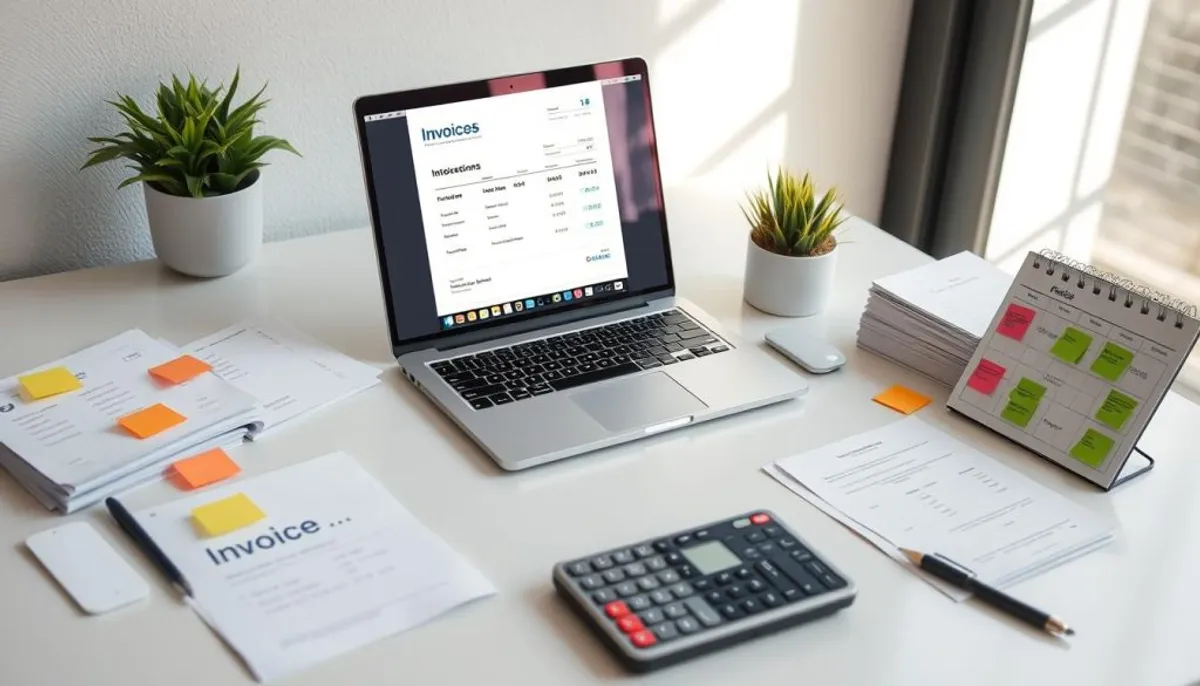Operating a business is a formidable endeavor, and the presence of unpaid invoices can exacerbate the challenge. If you find yourself grappling with the issue of unpaid invoices, you are part of a larger community. This predicament can significantly hinder cash flow and stifle growth.
For 60% of U.S. small and medium enterprises, overdue payments are a persistent source of frustration. Such delays can disrupt financial planning, leading to difficulties in meeting your own obligations. This creates a chain reaction that can destabilize your entire business ecosystem.

Fortunately, there are proven strategies to navigate debt collection and rectify overdue payments. This guide will introduce you to essential steps, from establishing transparent payment terms to exploring legal avenues. By following these practical recommendations, you can reclaim what is owed to you and maintain the financial health of your enterprise.
Key Takeaways
- Unpaid invoices affect 54% of small business owners
- Clear payment terms can improve timely payments
- Friendly reminders increase the chance of prompt payment
- Late payment fees can motivate clients to pay on time
- Accepting credit cards can smooth out payment processes
- Debt collectors can recover 60-80% of outstanding accounts
- Business management software can speed up payment to 14 days on average
Understanding Unpaid Invoices and Their Impact
Unpaid invoices are a significant challenge for businesses, notably small ones. Effective management of accounts receivable is essential for maintaining a healthy cash flow and sustaining operations. We will explore the differences between outstanding and overdue invoices, their financial impact, and common reasons for late payments.
Defining Outstanding vs. Overdue Invoices
Outstanding invoices are unpaid bills within the agreed payment period. Overdue invoices have passed their due date without payment. A 2022 study revealed that 49% of invoices issued by US businesses become overdue, highlighting the prevalence of this issue.
The Financial Impact on Small Businesses
Unpaid invoices create cash flow gaps, affecting a business’s ability to cover operational costs. Small and medium-sized businesses in the US spend at least 15 days annually chasing late payments. This diverts resources from productive activities and complicates financial planning.
Common Reasons for Late Payments
Late payments occur due to various factors:
- Customer financial hardships
- Disputes or errors in billing
- Poor communication
- Lack of prompt follow-up
| Country | Percentage of Accountants Chasing Late Payments |
|---|---|
| United Kingdom | 90% |
| United States | 94% |
| Australia | 95% |
Understanding these aspects is vital for effective invoice recovery and maintaining healthy business finances. Implementing strong accounts receivable management practices can mitigate the negative impacts of unpaid invoices and improve overall financial stability.
Setting Clear Payment Terms and Expectations
Establishing clear invoice payment terms is crucial for efficient collections. Businesses often spend an average of 14 hours weekly on late payment chases. This equates to nearly two full workdays lost to overdue invoices. To circumvent this, it’s vital to set forth clear billing policies from the outset.
Ensure every invoice includes payment deadlines. Standard terms might be payment upon receipt, net 30, or net 60. It’s also important to note that larger corporations may have unique payment protocols. Notify customers of any policy adjustments well in advance to avert any confusion.
Businesses that diligently pursue 90% or more of their invoices tend to see payments within a week of the due date. To enhance this process, consider leveraging automated invoicing systems. These tools facilitate the sending of reminders and the tracking of payment status, thus saving considerable time and bolstering cash flow.
Providing diverse payment options can also prompt quicker payments. Clearly outline each payment method on your invoices. Given that over half of emails are initially accessed on mobile devices, ensure your payment options are mobile-optimized.
By setting clear expectations and simplifying payment processes, you’ll significantly reduce the time invested in payment chases. This, in turn, will enhance your business’s financial well-being.
Effective Invoicing Practices to Prevent Late Payments
Implementing effective invoicing practices is crucial for businesses to maintain a healthy cash flow. By adopting smart strategies, you can significantly reduce the chances of late payments and improve your overall financial health.
Creating Clear and Detailed Invoices
Clear, detailed invoices are the foundation of effective invoicing practices. Include all necessary information such as itemized services, payment terms, and due dates. This clarity helps clients understand their obligations and reduces confusion that might lead to delayed payments.

Implementing Automated Invoicing Systems
Automated billing systems streamline the invoicing process, reducing errors and saving time. These systems can send out invoices automatically, set up payment reminders, and track payment status. By leveraging automated invoicing, businesses can cut average payment times from over 30 days to just 14 days.
Offering Multiple Payment Options
Providing various payment methods makes it easier for clients to pay promptly. Accept credit cards, ACH transfers, and wire payments to accommodate different preferences. This flexibility can significantly decrease delayed payments and improve cash flow. Some businesses even offer incentives like early payment discounts to encourage timely settlements.
| Payment Method | Benefits |
|---|---|
| Credit Cards | Convenience, immediate payment |
| ACH Transfers | Lower fees, good for recurring payments |
| Wire Transfers | Secure, suitable for large amounts |
By implementing these effective invoicing practices and embracing automated billing solutions, businesses can significantly reduce late payments and improve their financial stability.
How to Claim Unpaid Invoices: A Step-by-Step Approach
Recovering unpaid invoices necessitates a structured methodology. The process of invoice collection can be daunting, yet a meticulously crafted strategy enhances your likelihood of success. This guide outlines a step-by-step approach to effectively manage the invoice recovery process:
1. Initiate with a courteous reminder email two days post-due date. This initial prompt often rectifies minor oversights.
2. Subsequently, escalate with a more assertive reminder eight days after the due date. Include comprehensive invoice details and underscore the urgency of timely payment.
3. Engage in a direct phone call on day 15. Direct communication can unveil underlying issues, facilitating expedited resolutions.
4. On day 20, dispatch a formal email, copying pertinent stakeholders. This action escalates the matter within the client’s organizational framework.
5. If necessary, escalate to a certified letter on day 25. This step signifies the gravity of the situation and establishes a documented record.
It is crucial to maintain persistence in the invoice collection endeavor. Research indicates that 30% of outstanding invoices necessitate three or more reminders for resolution. Throughout your efforts, maintain a professional yet firm demeanor.
In the event of continued non-payment, consider involving account managers or exploring legal avenues. Small claims court presents a cost-effective option, with filing fees ranging from $15 to $75, contingent upon your state’s regulations.
Sending Friendly Payment Reminders
Payment reminder emails are essential for managing invoice follow-up and ensuring timely payments. They can save businesses significant time and resources. In the UK, late payments cost businesses an average of 208 hours annually.
Timing Your Reminders Effectively
Initiate your reminder process early to enhance the likelihood of on-time payments. A friendly reminder 5-7 days before the due date is advisable. On the due date, send an early morning email with a clear call-to-action. If the payment remains unpaid, follow up 2-7 days afterward.
Crafting Polite Yet Firm Reminder Messages
Employ a polite tone in your payment reminder emails to preserve client relationships. Include relevant payment details and a clear subject line to increase open rates. Explain the consequences of late payments while providing contact information for addressing any issues.
Using Various Communication Channels
Utilize diverse communication methods to ensure your message reaches clients. While email is the primary method, consider text messages, phone calls, or physical mail for follow-ups. This multi-channel approach can improve response rates and expedite payments.
| Reminder Stage | Timing | Communication Method |
|---|---|---|
| Pre-due Date | 5-7 days before | |
| Due Date | Morning of | Email, Text |
| First Follow-up | 2-7 days after | Email, Phone |
| Second Follow-up | 14-30 days after | Email, Phone, Mail |
After receiving payment, send a thank-you message to nurture client relationships and encourage future timely payments. By implementing these strategies, businesses can effectively manage their invoice follow-up process and minimize late payments.
Negotiating Payment Plans for Overdue Accounts
Confronting persistent non-payment through payment plan negotiation can be transformative. It presents a mutually advantageous solution, enabling clients to manage their finances while you collect the due amount. Let’s examine key strategies for securing flexible payment arrangements.

Arming your team with negotiation skills can dramatically alter cash flow and bolster your brand’s image. Basic negotiation tactics enhance late payment recovery and customer satisfaction. By employing empathetic tactics, you forge agreements that benefit both sides in discussions about past-due accounts.
Grasping the underlying interests of all parties through attentive listening is pivotal in securing favorable payment terms. The top-down negotiation method, beginning with full payment and descending to acceptable terms, proves effective. Proposing enhanced recurring payment plans, such as increased monthly installments or initial down payments, accelerates debt clearance.
| Negotiation Strategy | Benefits |
|---|---|
| Tactical Empathy | Mutually beneficial deals |
| Active Listening | Successful payment term negotiation |
| Top-down Approach | Effective in reaching agreeable terms |
| Flexible Payment Plans | Faster debt repayment |
Investing in call scripts, training initiatives, and software can streamline negotiation processes and fortify payment agreements. It’s essential to maintain clear communication and formalize agreements when offering flexible payment options. By honing these strategies, you’ll significantly boost your success in collecting overdue payments while preserving client relationships.
Implementing Late Payment Fees and Penalties
Late payment penalties serve as a potent tool for businesses aiming to foster timely payment habits. It is imperative to navigate the legal landscape and ensure transparent communication with clients when introducing invoice late fees.
Legal Considerations for Late Fees
Regulations surrounding late payment penalties vary across states. For example, Delaware limits late fees to 5% per month, with a grace period of five days. In contrast, Iowa caps late fees at $60 monthly for balances under $700 and $100 for higher amounts. Businesses must thoroughly research their state’s laws before establishing late fee policies.
Communicating Fee Policies to Clients
Transparent communication is paramount when introducing late fees. Include your late payment policy in the initial sales agreement and on invoices. This strategy safeguards your business while also educating clients about the repercussions of delayed payments.
Enforcing Late Payment Charges
Consistency is essential when applying late fees. Small businesses often set late fees between 1-1.5% monthly. To determine the late fee, apply the following formula: (Total Payment Owed) x (% Monthly Late Fee Rate) = Late Fee.
| Late Fee Type | Typical Range | Considerations |
|---|---|---|
| Percentage-based | 1-2% of past-due amount | Scales with invoice size |
| Flat fee | $25-$50 | Simple to calculate |
| Interest rate | 10% annual rate | Accumulates monthly |
While late fees can encourage timely payments, it’s vital to preserve client relationships. Offering payment plans or occasional extensions to loyal customers facing temporary financial hurdles can be beneficial.
When to Consider Professional Debt Collection Services
Unpaid invoices can severely impact your business’s cash flow. If you’ve tried every internal method to recover payment, it’s time to seek professional assistance. Debt collection agencies bring specialized expertise to the table, enhancing your chances of payment recovery.
The timing for professional invoice recovery is critical. While most invoices should be addressed within 45 days past due, experts recommend waiting 90 days before resorting to collections. This delay allows for internal resolution attempts and preserves customer relationships.
Debt collection agencies charge a percentage of the recovered amount, typically between 20-50%. Despite the fee, their services are invaluable, notably for small businesses lacking the resources for extensive follow-ups. These agencies focus on negotiating payment plans if full payment is not possible, usually after 180 days.
When selecting a debt collection agency, consider several factors:
- Membership in the Commercial Collection Agency Association
- Certification by the Commercial Law League of America
- Appropriate state licensure
- Experience with businesses in your industry
Remember, professional debt collection is governed by the Federal Fair Debt Collection Practices Act. This regulation ensures ethical practices and safeguards debtors from harassment. By utilizing the expertise of debt collection agencies, you can concentrate on your core business while improving your chances of recovering outstanding payments.
Legal Options for Recovering Unpaid Invoices
When conventional methods fail, businesses may turn to legal remedies for unpaid invoices. This move is vital for reclaiming substantial debts and establishing precedents for future dealings.
Sending Formal Demand Letters
The initial legal action involves sending a formal demand letter. This document meticulously outlines invoice details and sets a final payment deadline. It is imperative to dispatch these letters via certified mail with return receipt requested. This creates a verifiable record of your collection endeavors.
Filing Small Claims Court Lawsuits
For debts under a certain threshold, small claims court emerges as a viable option. This avenue is characterized by its swiftness and lower costs compared to traditional court proceedings. Approximately 30% of small and medium-sized enterprises encounter issues with unpaid invoices, rendering small claims court a frequent choice.
Pursuing Legal Action for Larger Debts
For more substantial debts, district court litigation may be necessary. Prior to embarking on this path, it is advisable to consult a legal professional to evaluate your case’s viability and grasp local court procedures. It’s worth noting that companies can initiate bankruptcy actions for debts exceeding $5,000 or file winding up petitions for debts surpassing $750.
While legal recourse can be both time-consuming and costly, it is sometimes indispensable for retrieving substantial debts. It is crucial to maintain open dialogue with delinquent customers to circumvent exorbitant legal expenses and safeguard business relationships.
Conclusion
Effective invoice management is vital for maintaining a healthy cash flow in businesses. Implementing clear payment terms and using automated invoicing systems can greatly reduce late payments. Statistics reveal that less than 1% of cases need court action for debt collection, underscoring the significance of proactive measures against unpaid invoices.
Businesses must understand the financial repercussions of unpaid invoices, including potential cash flow issues and tax complications. For instance, cash-method accounting does not allow for writing off unpaid invoices, whereas accrual-based accounting does. The IRS demands strict proof for writing off bad debt, stressing the importance of detailed documentation of collection efforts.
In scenarios where invoices remain unpaid, businesses have several avenues to pursue. Engaging a debt collection agency can enhance the likelihood of settling outstanding invoices. Legal action, such as filing a court complaint, is typically a last resort, with clients usually given 30 days to respond. By prioritizing effective invoice management and preventing late payments, businesses can alleviate financial stress and focus on growth rather than chasing unpaid debts.
RelatedRelated articles



